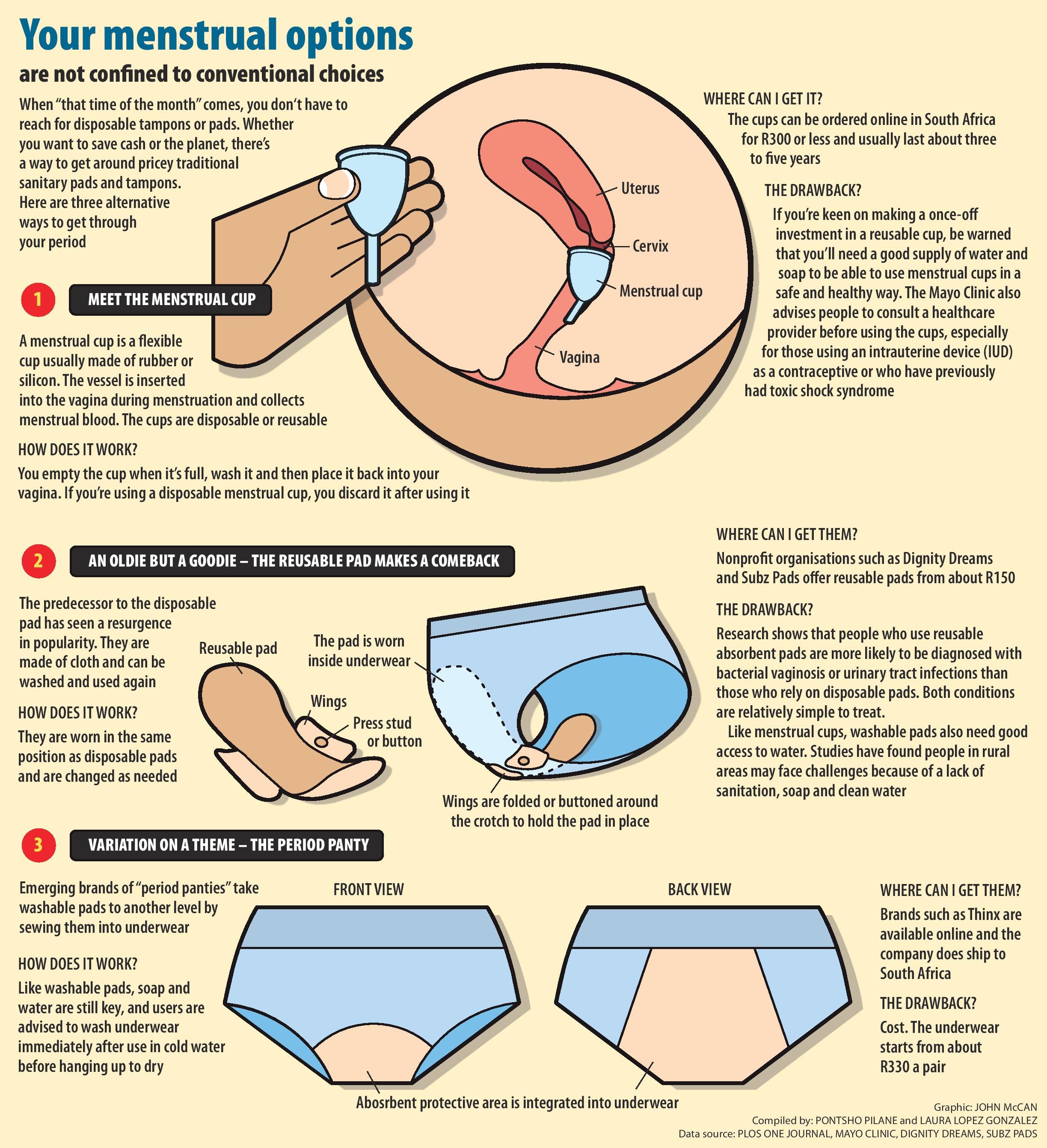Menstrual cups
Whether you’re looking to save cash or the planet, there’s a way to get around pricey traditional sanitary pads and tampons.
The average woman will use up to 17 000 sanitary pads or tampons in her lifetime, according to statistics cited in a 2014 study published in the British Journal of Medicine & Medical Research. If the average store brand sanitary pad costs about R2.33 each, that means the average woman could spend up to almost R40 000 on sanitary pads in her lifetime based on these estimates. Ultimately, at least 20 billion used pads and tampons end up in the world’s landfills each year, the study says.
But you don’t have to rely on traditional pads and tampons anymore. Here are three alternative ways to get through that time of the month.
1. Meet the menstrual cup: A menstrual cup is a flexible cup usually made of rubber or silicon. The vessel is inserted into the vagina during menstruation and collects menstrual blood. The cups are usually made of rubber or silicon and can be disposable or reusable, says US medical research organisation Mayo Clinic.
How does it work?
“If you’re using a reusable menstrual cup, you empty the cup when it’s full, wash it and then place it back in your vagina. If you’re using a disposable menstrual cup, you discard it after using it,” the Mayo Clinic explains on its website.
The number of times you would have to empty the cup depends on its size and your menstrual flow. Cups usually come in two sizes, small and large. Smaller cups are recommended for teens.
The cups can be ordered online in South Africa for R300 or less and usually last about three to five years.
The drawback? If you’re keen on making a once-off investment in a reusable cup, be warned that you’ll need a good supply of water and soap to be able to use menstrual cups in a safe and healthy way. The Mayo Clinic also advises people to consult a healthcare provider before using the cups, especially for those using an intrauterine device (IUD) as a contraceptive or who have had toxic shock syndrome previously. Toxic shock syndrome is a rare but life-threatening complication of certain types of bacterial infections and has historically been linked to the use of super-absorbent tampons.
Tampon tax: What’s the big deal?
[multimedia source=”http://bhekisisa.org/multimedia/2016-11-05-tampon-tax-whats-the-big-deal”]
2. An oldie but a goodie – the reusable pad makes a comeback: The predecessor to the disposable pad has seen a resurgence in popularity. The cloth pads offering users the comfort of pads without the recurrent costs and prove you don’t have to ditch pads to be financially savvy and environmentally friendly.
The pads have taken South Africa by storm with non-profit organisations, such as Dignity Dreams and Subz Pads, supplying them in low-income communities.
In India, between 43% and 88% of girls wash and reuse cotton cloths rather than use disposable pads, says a 2015 study published in the Plos One journal. Cleaning cloth pads is easy: you just soak them in water to remove stains, wash them with soap and hang them outside to dry. The sunlight helps to kill germs, says Dignity Dreams.
The drawback? The research also found people who used reusable absorbent pads were more likely to be diagnosed with bacterial vaginosis or urinary tract infections than women who relied on disposable pads. Both conditions are usually simple to treat.
Like menstrual cups, washable pads also need good access to water. The study says that in rural areas women may face challenges due a lack of sanitation, soap and clean water. They may also battle with social taboos and restrictions forcing the drying indoors, away from sunlight and open air, it adds.
3. The variation on a theme – The period panty: Emerging brands of “period panties” take washable pads to another level by sewing them into underwear. One of the leading brands, Thinx, offers a range of underwear styles. Each style from “boy shorts” to thongs has a different level of absorbency, measured in tampons. The brand’s “hip hugger”, for example, holds about two tampons’ worth of blood for heavy days.
Like washable pads, soap and water are still key, and users are advised to wash underwear immediately after use in cold water before hanging up to dry. While health precautions may be similar to those associated with washable pads, no published research exists on this specific brand of period panties.
The drawback? Cost. While Thinx are available online and the company does ship to South Africa, underwear starts from about R330 per pair.

Additional reporting by Laura Lopez Gonzalez
Bhekisisa health reporter Pontsho Pilane won the Livity Africa Parliament Challenge when she was an honours student at the University of the Witwatersrand and put forward a policy proposal to Parliament for the provision of free sanitary pads to disadvantaged people. She will be presenting in Parliament soon.
Tell us what you think – make a comment and rate our story on a scale of 1 (really bad) to 10 (excellent). We’d love to hear from you.